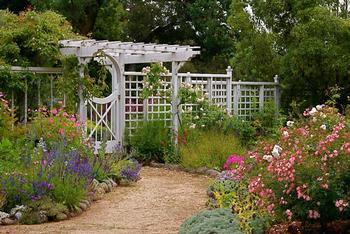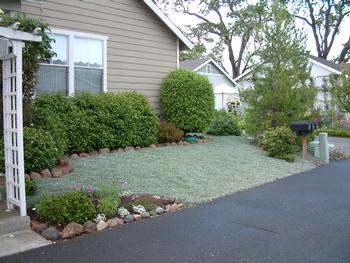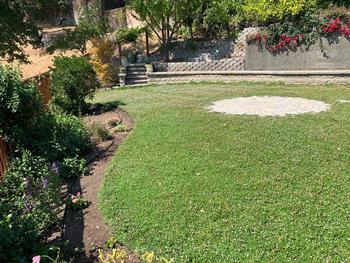Lawn alternatives: what to know before you grow
-
Marie Narlock
-
If I told you that making one change to your landscape could save you significant water, energy, money, and time, would you be interested? What if I told you that someone would pay you to make this change or even do it for you? And finally, what if this change would benefit the environment in a multitude of ways?
 Low-water perennials uses much less water than a lawn and invites bees, butterflies, and hummingbirds into the garden. Photo: Gail Mason
Low-water perennials uses much less water than a lawn and invites bees, butterflies, and hummingbirds into the garden. Photo: Gail MasonAre you game?
I'm talking about replacing your lawn. You know, that high-maintenance thing that came with your house. The one you need to mow, clip, edge, aerate, feed, seed, weed, and water.
This is an ideal time to replace your lawn. Not only will you conserve water, but you can take advantage of special programs offered through the Marin Municipal and North Marin Water Districts.
These organizations have offered cash-for-grass incentives, free materials, and even sheet mulch installation. (Sheet mulching is the process by which a lawn is snuffed out by applying layers of cardboard and mulch on top of it.) Look online to see what your water company is offering now.
What should you put where your lawn was?
Getting rid of a lawn is the easy part. Deciding what to put there instead is often the head-scratcher. Start by identifying exactly how you want to use the space.
Do you need to walk on that area or a portion of it? Do you want to sit in that area? Will your kids or dogs play there? Do you need to block or enhance a view? Want to start a vegetable garden? Or invite pollinators into the garden?
There are oodles of possibilities – and the answer depends on what you want or need.
Flat, fluffy or fluttery: lawn alternatives for every taste
Let's say you want something that replicates what your lawn was doing. No problem. There are many flat, low-water, walkable lawn alternatives. Silver carpet is an alternative to grass that sprouts pretty yellow flowers in summer. It's walkable, drought-tolerant & deer resistant. PlantMaster
Silver carpet is an alternative to grass that sprouts pretty yellow flowers in summer. It's walkable, drought-tolerant & deer resistant. PlantMasterIf you can't bear the thought of a lawn-free existence, consider a California native sod mix (look online for vendors) or the Caitlin sedge (Carex texensis), a grass-like plant that works in sun or shade and only requires mowing once a year to keep it four to six inches tall.
Another walkable contender is silver carpet (Dymondia margaretae), a tough-as-nails dense gray mat that snuffs out weeds as it clings to the ground, or creeping thyme (Thymus reiter), which emits a lovely fragrance when gently stepped upon.
Or here's an idea: how about white clover (trifolium repens)? This "lawn weed" is easy and versatile. It grows in sun or shade, stays low and green all year, and grows in poor soil. As an added bonus for dog lovers, it doesn't show pet urine stains. One note of caution? Be sure to get weed-free seed.
UC researchers helped study the irrigation needs of a walkable lawn alternative called Kurapia. It's fast-growing, drought-proof, and not picky about soil. Thanks to its extra deep roots, it also helps stabilize steep slopes. Kurapia is an easy-care groundcover that grows about an inch tall. Bees love the spring-summer flowers you can leave on or mow. Photo: Jo Sherlin
Kurapia is an easy-care groundcover that grows about an inch tall. Bees love the spring-summer flowers you can leave on or mow. Photo: Jo SherlinWhat if you'd like a grassy look but don't necessarily need to walk on it? In that case, you can opt for a fluffy look. And by fluffy I mean larger grasses that grow up to a couple feet tall and gracefully bend and blow in the breeze.
Like their lower-growing cousins, many sedges work beautifully in this role. Dune sedge (Carex pansa), field sedge (Carex praegracilis), and foothill sedge (Carex tumulicola) are excellent options. For a charming springtime, meadow look, plant an expanse of any one of these, interspersed with a few boulders and lots of bulbs.
To dial things up further, consider adding plants that invite bees, butterflies, and hummingbirds. There's' nothing like the buzz and flutter of wings in the garden. Fortunately, there are many bodacious bloomers that hang out the welcome sign for these winged visitors.
To learn more, visit the Marin Master Gardener website and click on plants. You'll find many useful plant lists, complete with photos and growing instructions.



